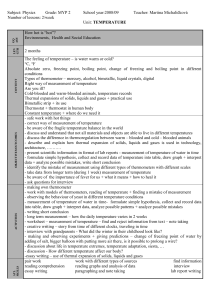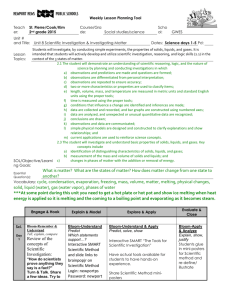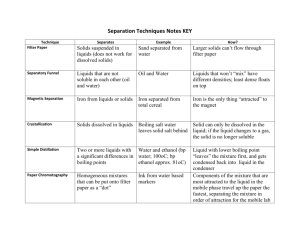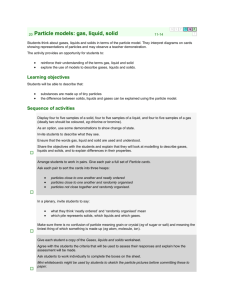Introduction to Solids, Liquids, and Gases
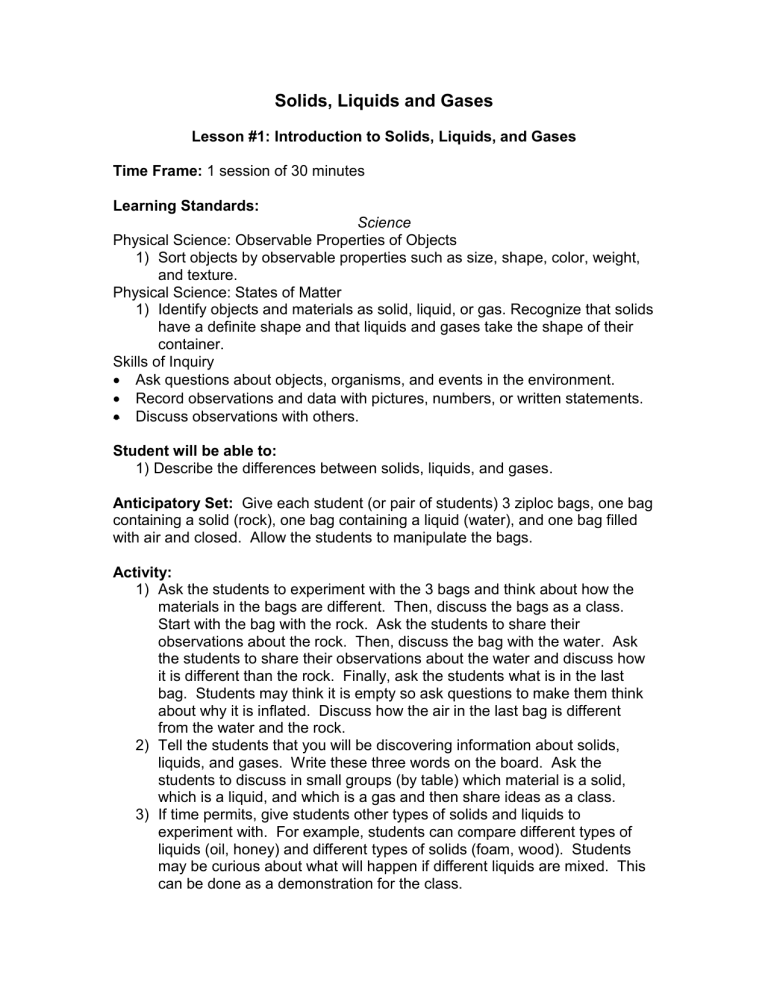
Solids, Liquids and Gases
Lesson #1: Introduction to Solids, Liquids, and Gases
Time Frame: 1 session of 30 minutes
Learning Standards:
Science
Physical Science: Observable Properties of Objects
1) Sort objects by observable properties such as size, shape, color, weight, and texture.
Physical Science: States of Matter
1) Identify objects and materials as solid, liquid, or gas. Recognize that solids have a definite shape and that liquids and gases take the shape of their container.
Skills of Inquiry
Ask questions about objects, organisms, and events in the environment.
Record observations and data with pictures, numbers, or written statements.
Discuss observations with others.
Student will be able to:
1) Describe the differences between solids, liquids, and gases.
Anticipatory Set: Give each student (or pair of students) 3 ziploc bags, one bag containing a solid (rock), one bag containing a liquid (water), and one bag filled with air and closed. Allow the students to manipulate the bags.
Activity:
1) Ask the students to experiment with the 3 bags and think about how the materials in the bags are different. Then, discuss the bags as a class.
Start with the bag with the rock. Ask the students to share their observations about the rock. Then, discuss the bag with the water. Ask the students to share their observations about the water and discuss how it is different than the rock. Finally, ask the students what is in the last bag. Students may think it is empty so ask questions to make them think about why it is inflated. Discuss how the air in the last bag is different from the water and the rock.
2) Tell the students that you will be discovering information about solids, liquids, and gases. Write these three words on the board. Ask the students to discuss in small groups (by table) which material is a solid, which is a liquid, and which is a gas and then share ideas as a class.
3) If time permits, give students other types of solids and liquids to experiment with. For example, students can compare different types of liquids (oil, honey) and different types of solids (foam, wood). Students may be curious about what will happen if different liquids are mixed. This can be done as a demonstration for the class.
4) Discuss the solid, liquid, and gas chart (laminated, provided by the teachers) with the students. Then, as a class, fill in the chart about solids, liquids, and gases with discussion and demonstrations from the different types of solids, liquids, and gases, investigated during this lesson. Some parts of the chart may remain blank and can be filled in and returned to after future lessons. This chart will be a good reference point as this unit progresses.
5) Pass out the solid, liquid, and gas student worksheet and ask students to complete it working in small groups (by table). If necessary, write the names of 6 substances on the board (2 solids, 2 liquids, and 2 gases and let the students decide where to write them (i.e. are they solids, liquids, or gases?).
Closure: Discuss the following ideas and questions with the students. How do we know if something is a solid? A liquid? A gas? How are solids, liquids, and gases different? Can a solid change into a liquid? A gas? Point to different objects are the room and ask the students to identify them as either a solid, liquid, or gas.
Assessment: Participation in class discussions and activities (student worksheet)
Resources and Materials: Ziploc bags with rocks, water, and air, sealed containers with different types of liquids (honey, oil), foam, wood, solid, liquid, and gas student worksheets, solid, liquid, and gas laminated chart

